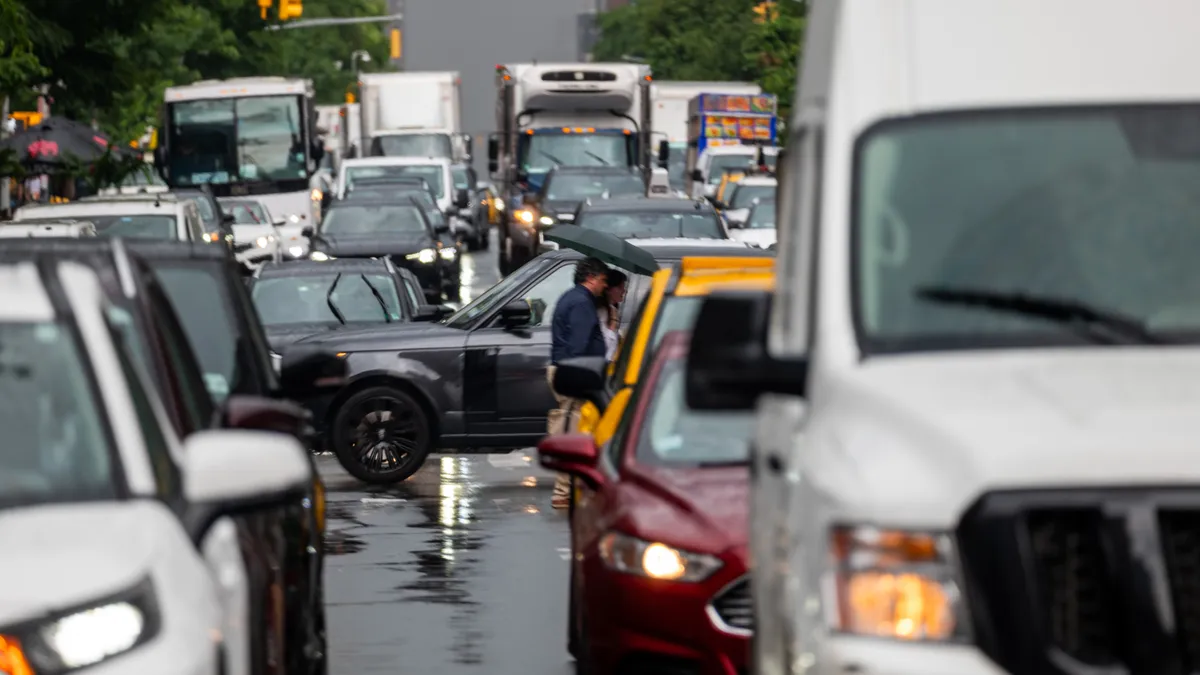Ralf-Peter Schäfer is vice president for traffic and travel information at TomTom, a global location technology and mapping company.
Around the world, cities are grappling with how to mitigate rising traffic levels, which not only cause frustration among road users but also pose serious implications for health and safety. New York City nearly implemented a first-in-the-nation solution: a congestion surcharge. While the surcharge was postponed indefinitely just before its planned introduction in June 2024, New York traffic hasn’t gone anywhere, and it’s crucial to step back and ask ourselves which solutions can truly fix New York’s traffic crisis.
New York traffic has reached a critical point regarding its impact on the economy, road safety and emissions. According to TomTom’s annual Traffic Index, New York is the most congested city in the United States, and in 2023, each New York driver contributed an average 511 pounds of carbon dioxide emissions annually and lost 108 hours during rush hour as a direct result of traffic. While only about 12% of New York residents commute to Manhattan via car, more than 800,000 vehicles enter the central business district each day.
While New York would have been the first U.S. city to introduce congestion pricing, it is not the first globally. London’s congestion tax, introduced 20 years ago, mirrors New York’s proposed model. Meanwhile, Singapore’s dynamic traffic pricing model adjusts costs based on peak driving times and reduces fees when traffic is openly flowing. By analyzing successes in Singapore and shortcomings in London, it’s clear that New York’s congestion surcharge would have needed several adjustments to achieve its traffic reduction goals. While the surcharge remains in limbo, we can instead look into other traffic reduction tactics, such as reallocating existing urban spaces.
Lessons to learn from global congestion pricing
London’s similarities to the NYC surcharge exemplify the policy’s weaknesses. While London’s congestion tax at first resulted in reduced traffic, these improvements were short-lived, as traffic ultimately returned to the same levels. This happened due to a shift in driver demographics. While use of private cars within congestion zones decreased, those gaps were quickly filled by an influx of ride-sharing vehicles. Despite London’s vast metro and bus system, demand instead shifted towards ride-hailing services, and drivers experiencing higher volumes appear unbothered by the cost of entering congestion zones. However, London also has low- and ultra low-emission zones with hefty fees for non-compliant vehicles, which have successfully reduced CO2 emissions by 1.76 billion pounds.
Interestingly, New York’s proposed congestion pricing included a drastically reduced fee for ride-sharing services. While proposed tolls were set at $15 for cars and $7.50 for motorcycles, only $1.25 was to be added to a yellow cab passenger’s fare, and $2.50 for Uber and Lyft riders. Considering that ride-sharing fares can surge to $39 per mile in New York City, it’s unlikely that paying an extra few dollars for the congestion surcharge would have done much to deter regular riders from entering the city.
Meanwhile, Singapore adopted congestion pricing nearly 50 years ago when the city experienced significant population growth. Similarly to London and New York, the Area Licensing Scheme was initially a flat fee that drivers paid upon entering designated areas. Due to shortcomings associated with drivers that entered central zones multiple times a day, Singapore shifted in 1988 to Electronic Road Pricing, an automated system that adjusts rates based on vehicle type, speed, location and time of day.
Though it’s important to consider that Singapore also makes it prohibitively expensive to own and drive a car, the ERP system still proved effective. Since the most recent update to its policy, Singapore has reduced weekday traffic within designated zones by 24%. Because ride-sharing and taxi drivers can offer passengers the choice between ERP routes and non-ERP routes with different pricing options, Singapore has successfully incentivized the avoidance of highly trafficked areas, exemplified by public transit ridership increasing from 59% to 66% between 2008 and 2015 and the subsequent reduction in CO2 emissions by 176,400 pounds.
Beyond congestion pricing: Alternative methods to alleviate traffic
Overall, the introduction of congestion pricing in New York City may have been a first step towards supporting a larger-scale shift away from vehicles, but there is much more to be done. While there is no perfect solution to addressing the traffic problem, other manners of managing congestion exist. Take, for instance, the reallocation of existing infrastructure.
Building new roads and adding lanes is not only costly and time-consuming but impossible in densely populated urban areas like New York City. However, there are ways to improve how space is utilized to better manage traffic. Paris took a radical approach, banning cars from certain streets to make room for more pedestrian thruways and bike lanes. Despite an adjustment period, the increasing number of cyclists demonstrates that the city is moving towards its goals. Wales, meanwhile, simply lowered the default speed limit in highly congested areas to increase safety, indirectly encouraging more people to travel by foot or bicycle.
By leveraging data and technology, it is possible to successfully determine how cities across the world, including New York, can reimagine the way existing space is utilized. This extends to public transit as well. Chicago’s Department of Transportation recently announced new dedicated bus-only traffic lanes in an effort to improve bus reliability and reduce travel times, further incentivizing traveling via public transportation instead of cars. It is small changes such as these that will transform how citizens move across cities, though results may not be immediately felt.
In an economy so car-dependent, shifting toward new ways of mobility will inevitably take time. While the New York City congestion surcharge never left the drawing board, it serves as a useful learning opportunity for other U.S. cities facing similar congestion challenges, such as Los Angeles, Chicago, Boston and San Francisco. While each region has distinct infrastructure and problems, a growing wealth of technology and data can help cities curate individualized solutions for a lasting impact.



















